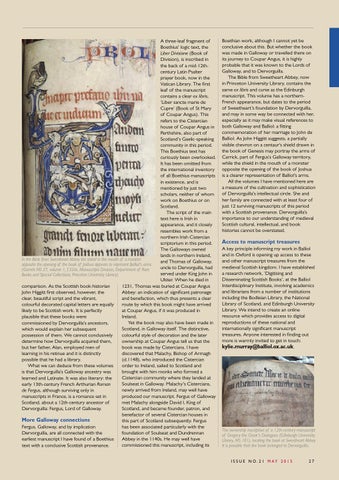A three-leaf fragment of Boethius’ logic text, the Liber Divisione (Book of Division), is inscribed in the back of a mid-12thcentury Latin Psalter prayer book, now in the Vatican Library. The first leaf of the manuscript contains a clear ex libris, ‘Liber sancte marie de Cupre’ (Book of St Mary of Coupar Angus). This refers to the Cistercian house of Coupar Angus in Perthshire, also part of Scotland’s Gaelic-speaking community in this period. This Boethius text has curiously been overlooked. It has been omitted from the international inventory of all Boethius manuscripts in existence, and is mentioned by just two scholars, neither of whom work on Boethius or on Scotland. The script of the main text here is Irish in appearance, and it closely resembles work from a northern Irish Cistercian scriptorium in this period. The Galloways owned lands in northern Ireland, In the Bible from Sweetheart Abbey the shield in the mouth of a monster and Thomas of Galloway, opposite the opening of the book of Joshua appears to represent Balliol’s arms uncle to Dervorguilla, had (Garrett MS 27, volume 1, f.326r, Manuscripts Division, Department of Rare served under King John in Books and Special Collections, Princeton University Library). Ulster. When he died in 1231, Thomas was buried at Coupar Angus comparison. As the Scottish book-historian Abbey: an indication of significant patronage John Higgitt first observed, however, the and benefaction, which thus presents a clear clear, beautiful script and the vibrant, route by which this book might have arrived colourful decorated capital letters are equally at Coupar Angus, if it was produced in likely to be Scottish work. It is perfectly Ireland. plausible that these books were Yet the book may also have been made in commissioned by Dervorguilla’s ancestors, Scotland, in Galloway itself. The distinctive, which would explain her subsequent colourful style of decoration and the later possession of them. We cannot conclusively ownership at Coupar Angus tell us that the determine how Dervorguilla acquired them, book was made by Cistercians. I have but her father, Alan, employed men of discovered that Malachy, Bishop of Armagh learning in his retinue and it is distinctly (d.1148), who introduced the Cistercian possible that he had a library. order to Ireland, sailed to Scotland and What we can deduce from these volumes brought with him monks who formed a is that Dervorguilla’s Galloway ancestry was Cistercian community where they landed at learned and Latinate. It was also literary: the Soulseat in Galloway. Malachy’s Cistercians, early 13th-century French Arthurian Roman newly arrived from Ireland, may well have de Fergus, although surviving only in produced our manuscript. Fergus of Galloway manuscripts in France, is a romance set in met Malachy alongside David I, King of Scotland, about a 12th-century ancestor of Scotland, and became founder, patron, and Dervorguilla: Fergus, Lord of Galloway. benefactor of several Cistercian houses in More Galloway connections this part of Scotland subsequently. Fergus has been associated particularly with the Fergus, Galloway, and by implication foundation of Soulseat and Dundrennan Dervorguilla, are all connected with the Abbey in the 1140s. He may well have earliest manuscript I have found of a Boethius commissioned this manuscript, including its text with a conclusive Scottish provenance.
Boethian work, although I cannot yet be conclusive about this. But whether the book was made in Galloway or travelled there on its journey to Coupar Angus, it is highly probable that it was known to the Lords of Galloway, and to Dervorguilla. The Bible from Sweetheart Abbey, now in Princeton University Library, contains the same ex libris and curse as the Edinburgh manuscript. This volume has a northernFrench appearance, but dates to the period of Sweetheart’s foundation by Dervorguilla, and may in some way be connected with her, especially as it may make visual references to both Galloway and Balliol: a fitting commemoration of her marriage to John de Balliol. As John Higgitt suggests, a partially visible chevron on a centaur’s shield drawn in the book of Genesis may portray the arms of Carrick, part of Fergus’s Galloway territory, while the shield in the mouth of a monster opposite the opening of the book of Joshua is a clearer representation of Balliol’s arms. All the volumes I have mentioned here are a measure of the cultivation and sophistication of Dervorguilla’s intellectual circle. She and her family are connected with at least four of just 12 surviving manuscripts of this period with a Scottish provenance. Dervorguilla’s importance to our understanding of medieval Scottish cultural, intellectual, and book histories cannot be overstated. Access to manuscript treasures A key principle informing my work in Balliol and in Oxford is opening up access to these and other manuscript treasures from the medieval Scottish kingdom. I have established a research network, ‘Digitising and Disseminating Scottish Books’, at the Balliol Interdisciplinary Institute, involving academics and librarians from a number of institutions including the Bodleian Library, the National Library of Scotland, and Edinburgh University Library. We intend to create an online resource which provides access to digital reproductions of these national and internationally significant manuscript treasures. Anyone interested in finding out more is warmly invited to get in touch: kylie.murray@balliol.ox.ac.uk.
The ownership inscription of a 12th-century manuscript of Gregory the Great’s Dialogues (Edinburgh University Library, MS 101), locating the book at Sweetheart Abbey. It is possible that the book belonged to Dervorguilla. i s s u e n o . 2 1 MA Y 2 0 1 5
27
